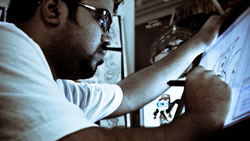 Kshiraj Telang is a video game artist who works at Lakshya Digital. In his ten years of multidisciplinary experience, Kshiraj debuted as a 2D traditional animator and later developed himself as an artist for stylized art that suits iOS and smart phone games but not just limited to these.
Kshiraj Telang is a video game artist who works at Lakshya Digital. In his ten years of multidisciplinary experience, Kshiraj debuted as a 2D traditional animator and later developed himself as an artist for stylized art that suits iOS and smart phone games but not just limited to these.
At Lakshya, he has created art for some highly successful Facebook and ios games. In the past, he has worked for clients like Disney, Budweiser Budvar, MTV, Kingfisher, Samsung, etc.
At NASSCOM GDC 2012, held in Pune, India, Kshiraj conducted an interesting session on ‘Character Development for Video Games’.
AnimationXpress.com Ishpreet Chandock caught up with the artist himself talking about his role at Lakshya Digital, his views about the state of the Indian gaming industry and his experience at NASSCOM Game Developers Conference.
Here are the excerpts…..
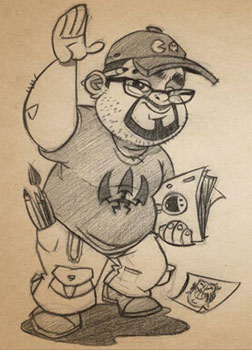 What is it that you do as a Game Artist?
What is it that you do as a Game Artist?
I draw and develop characters and environments for video games. Speaking of specialization, I am a character artist, and usually inclined to developing stylized art.
You’re the lead artist for Lakshya Digital. What does this entail and how are you working with the team and the other artists to bring ideas to life?
It involves great fun at work when working with fellow artists at Lakshya. All of them are truly talented, and therefore we usually do each and every project with great fun and affection. My team comprises of artists skilled with various art style specialization. This allows all of us to learn from each other, and find and put the right talent into the right kind of project. At times I even take part in design brainstorming, or development and testing.
Are you a gamer? If so, what do you play? What games are you currently finding most intriguing?
Yes. I play on almost all platforms and enjoy side-scrolling adventure platformers the most. My favorites however are Super Mario 3D Land and The Legend of Zelda: Ocarina of Time
Does being a gamer influence the way you create your art?
Absolutely. Being a gamer allows me to understand the need of target audience better and therefore lets me create art that perfectly fits and serves the purpose. You get a better sense of details you should keep in a character design based on the target platform; understand the rightful timing of animation that’d help the player (gamer) find gameplay intuitive and fun. Social game art has to be handled in a method different than a FPS, and you’d know it only when you have played enough games.
Is art for tabletop RPGs different than art for computer RPGs or other games? How does the art aesthetic lend itself to each type of game?
One big difference is that the art for table-top RPGs is 2D while the art in a computer RPG is usually 3D. As your readers would know, the process and skills for creating 2D art is very different from that for 3D art.
What are your artistic influences in general? Are there any artists in particular you’re looking at for inspiration when designing art for Lakshya Digital?
I like edgy art and therefore take inspiration from great talents like Ben Caldwell, Humberto Ramos, Carlos Meglia, Jeff Agala, Mike Henry and the likes. I also love character designs of Stephen Silver and Francisco Herrera. Many fellow artists at Lakshya are a great source of inspiration too.
How do you initiate a project?
First of all I take full understanding of the game design (both by reading document and by having a verbal communication with the designer). I encourage the game designer to share and illustrate all the scribbles he did in order to understand his vision correctly. This exercise helps me borrow all information about the game mechanics and story, and guides me towards development of art. I then proceed to do art experiments to explore and invent style that might fit the game. Many other artists take part at this stage, suggesting sketches in various art forms. It’s always a good choice to even hear existing game names that comes in the mind of the designer when he thinks of his game. Some technical aspects also come in play when working for smartphone media. We do a prototype of the gameplay with a draft art that suggests mechanics and represents playing experience. Once we find the gameplay intuitive in the prototype, the art department steps into next phase.
How do you organize your work? Do you have a predefined working process?
I always prefer and try to start on my sketchbook and doodle the first visuals that come in my mind. However if I find myself blocked, I do not mind doing roughs on SketchbookPro or on iPad. Even a choice of whether to do characters, or environments/composition boards first is solely a choice that varies from project to project. In whatever we do, we always try to store every piece of artwork that we do (no matter it’s accepted or rejected). Game development sees a number of revisions, going back and forth, changes of thoughts, and it’s good to organize everything with a version log.
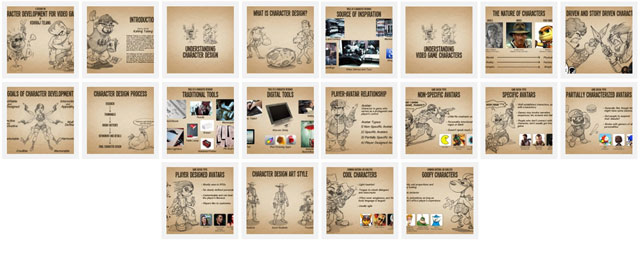
What are the tools of your trade and what is your relationship to these tools?
However being equipped with many digital tools, I love and depend the most on traditional tools like pencil and sketchbook. I find myself more connected with that media to express myself and deliver my best. Additionally, I enjoy working on Cintiq when I am doing highly precise work on a paperless pipeline. When I am mobile, I prefer to work on iPad or record my sketchbook drawings on Wacom Inkling.
What is the biggest technological limitation of your profession, and how do you deal with it?
I am pretty much overwhelmed with what the technology has to offer. I am yet to meet the full expectations of the technology we have at our disposal.
How do you see your profession evolving?
At one end if it starts to feel difficult to come with unique art style, on the other end innovative artists still manage to create stuffs never seen before. The industry surely is leaping forward and is always succeeding in offering new and unique art and concepts.
What are some of the things that you have worked on?
I’ve made art for smartphones and social games. I might not be able to share the names of any of them at this moment.
Who do you think are the top artists out there today?
The industry (both domestic and international) is full of great talent pool. At one end AAA artists are creating more and more polished art, on the other end indies are breaking all typical formulae, and delivering unique novelty stuff. I am in deepest love with the creators of Rayman Origins and Legends and really find their games high on standards w.r.t. quality of art.
What part of drawing is most fun and easy, and what is most hard?
It’s a relative question. I find myself at ease when I am supposed to draw cute girls, and the hardest when they ask for a spaceship design.
What are some of the things that you do to keep yourself creative?
I read subscriptions of a number of feeds on my Flipboard and Tumblr. I also keep a check on current industry trend by frequently visiting gaming news portals like IGN, GameSpot, IndianVideoGamer, Kotaku and MCVIndia. I prefer to take breaks and avoid non-stop work routine. A walk on the terrace at mid night with a big mug full of coffee and an old radio playing your favorite music lightens your mind and lets you think of fresh ideas.
What is your most favorite subject to draw? And why?
As I said, I love drawing cute and pretty girls. It’s something I enjoy the most as it receives most number of accolades and fan following. I find great satisfaction and fun when I get to draw rhythmic strokes for such drawings. Apart from that, I like illustrating pirates and cowboys.
What inspired you to become an Artist?
At a tender age, I was introduced to R. K. Laxman political cartoons, and that inspired me to aim and become an artist. However with passing time, I started to go far and far from newspaper cartooning, adopted digital and motion graphics, and transitioned to animation and then to gaming.
What are some of the neat things you have learned from other artists that you have worked with or seen?
I am fortunate to have worked with many fellow artists, rich with talents of all kinds. As I didn’t take any formal education for this profession, almost all of my learning has come through the time I have spent with fellow artists at work or the feed of Internet ramblings by artists around the world. Artists’ expresses themselves in various ways through a variety of art styles at work. Even country and cultural influences guide the lines and colors of artists from those regions, something I enjoy and learn from.
What led you to take up the role as an Art Lead at Lakshya Digital?
After spending a few years in traditional and digital animation, I did a couple of iOS games as freelance, and that gave me a direction in gaming and hence I joined Lakshya. My multidisciplinary knowledge and promising command on character art helped taking up the role as a Lead Artist at Lakshya.
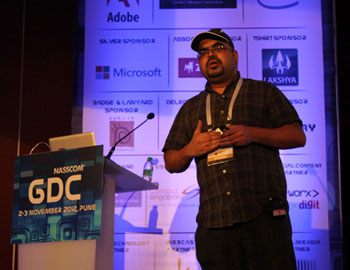 How was your experience at NASSCOM? What would be the highlights?
How was your experience at NASSCOM? What would be the highlights?
Coming to NGDC was a great experience, and I was delighted and satiated with all the speaker sessions I attended. I am hopeful that NGDC continues to get better and better from here on, and the Indian Gaming Industry continues to achieve more and more milestones.
In your opinion, and without revealing too much about your company’s plans, what types of skills do you believe will be critical in the future for those seeking careers within the video game industry?
“Play games and make good art”… that’s the only and important thing I recommend to the artists seeking career in the gaming industry.
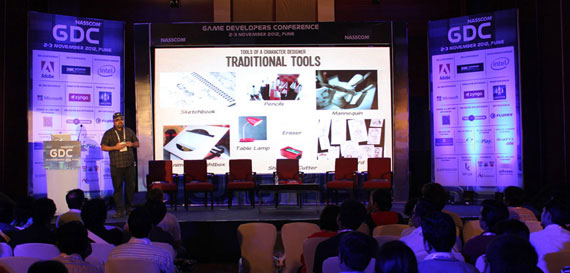
What do you wish you had known before starting in the industry?
I wish I could have become a gamer a little earlier than I did. I find myself a little disconnected and less aware from the gaming days of sixth generation of video game consoles. Therefore catching up with how the industry has progressed and what the games have become in the seventh and eighth generation took a bit of my time.
You started your career as a cartoonist but later diverted towards professional animation? Tell us about it?
I was always fascinated about the moving cartoons I saw on T.V. like all other kids that grew with me, and honestly I had no clue about how they are made even after months of starting my career as a cartoonist. Until a day in 2002 when I met an animation tool Toon Boom Studio, that stated it to be capable of letting you make cartoon animations. I got an evaluation copy from somewhere and burned midnight candle lamp to try and learn it before the trial ends. Luckily, that time was enough for me to complete a small animated reel that was liked by an animation studio and hence I was hired.
You have worked as a cartoonist in newspapers like “Dainik Bhaskar and Dandakaranya’.Tell us about your experience?
I was a tender school going kid then, so the experiences won’t sound professional in any way. Since I was in primary school, my mind wasn’t too sharp to think of humorous ideas that can go as political cartoons, but I had some ability to draw. Therefore my dad visualized ideas and captions for me, and I illustrated them to complete cartoons that got published in the state and national level newspapers. I loved displaying my published cartoon in the newspapers to the school assembly.
You have been awarded the Best Child Cartoonist in Maharastra at the age of 12,you are India’s first animation professional whose story was published on Toon Boom Studio website, your short films have been broadcasted and appreciated on various platforms including PVR cinema screens and international film festival, how does it feel?
Parle Cartoon Yatra a cartoon celebration event that happened in 1995 in Maharastra awarded me with that title when Cartoonist Ranade sir loved my work. While such appreciations encourage me, I don’t totally agree to a recognition like this for me. I am happy to see Toon Boom Inc. like my association with their products that made them do a user story on me.
What do you believe is the biggest misconception others have about working for a video game studio?
I do not want to tell any stories like ‘parents didn’t understand, landlord didn’t rent a house because of that’, etc. It’s an industry of a very specialized and uncommon skill and is bound to be misread by a layman. As playing games is improving as a culture, it’s getting easier for others to understand our profession.
